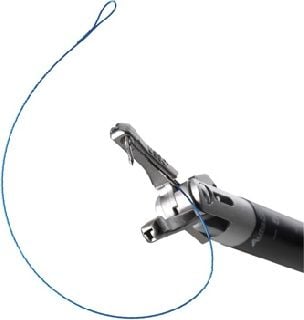The new device can increase operating room efficiency during weight loss surgery and other procedures. Bariatric surgery requires a tremendous amount of surgical stapling and suturing to make sure anastomotic closure. The capability to suture internal tissue laparoscopically without the need to tie knots can help surgeons shorten probably the most labor-intensive tasks performed during bariatric surgery. By combining proprietary automated needle-passing technology with a knotless suturing device, the V-Loc device for Endo Stitch and SILS Stitch devices offers distinctive benefits over hand suturing and conventional automated suturing options. The V-Loc device to be used with Endo Stitch has a unique barb and loop design, enabling faster suturing by eliminating the necessity to tie any knots and saving surgeons 35-42% of times necessary to suture within the body, according to a current pre-clinical study.
Covidien, a leading medical device manufacturer, has introduced a new knotless suturing device for use in minimal access surgery. The device, called V-Loc 180, is designed to provide surgeons with greater control and precision during laparoscopic procedures, while also reducing the risk of complications associated with traditional suturing techniques. In this essay, we will explore the features and benefits of the V-Loc 180 device, including its use in laparoscopic surgery, its impact on patient outcomes, and its potential to revolutionize surgical techniques.
Features of the V-Loc 180 Device
The V-Loc 180 device is a knotless suturing device designed for use in minimal access surgery. The device uses a unique barbed suture technology, which allows the surgeon to achieve a secure closure without the need for knots. The barbs on the suture anchor the tissue together, providing a strong and secure closure while also reducing the risk of tissue damage and inflammation.
The V-Loc 180 device also features a 180-degree curve, which allows the surgeon to maintain a consistent tension on the suture during closure. This provides greater control and precision during laparoscopic procedures, allowing the surgeon to achieve a more accurate closure and reduce the risk of complications associated with traditional suturing techniques.
Benefits of the V-Loc 180 Device
The V-Loc 180 device offers several benefits for patients and surgeons alike. For patients, the device can reduce the risk of complications associated with traditional suturing techniques, such as tissue damage, inflammation, and infection. The knotless closure also reduces the risk of suture-related complications, such as suture granulomas or knot migration.
For surgeons, the V-Loc 180 device provides greater control and precision during laparoscopic procedures, allowing them to achieve a more accurate closure with less risk of tissue damage or inflammation. The knotless closure also saves time in the operating room, allowing the surgeon to complete the closure more quickly and move on to other aspects of the procedure.
Impact on Patient Outcomes
The use of the V-Loc 180 device has been shown to have a positive impact on patient outcomes. In a clinical study, the device was found to provide a strong and secure closure in laparoscopic procedures, with no instances of suture failure or tissue damage. Patients who received a closure using the V-Loc 180 device also reported less pain and discomfort during the recovery period, compared to patients who received a closure using traditional suturing techniques.
The V-Loc 180 device has also been shown to reduce the risk of complications associated with traditional suturing techniques. In a study of patients undergoing laparoscopic procedures, the use of the V-Loc 180 device was associated with a significantly lower rate of suture-related complications, such as suture granulomas or knot migration.
Potential to Revolutionize Surgical Techniques
The V-Loc 180 device has the potential to revolutionize surgical techniques by providing surgeons with a new tool for achieving secure and precise closures during laparoscopic procedures. The device's unique barbed suture technology and 180-degree curve allow for greater control and precision during closure, while also reducing the risk of complications associated with traditional suturing techniques.
The V-Loc 180 device may also have implications for other types of surgery, such as open surgery or robotic-assisted surgery. The device's knotless closure and unique suture technology may allow for greater efficiency and precision in these types of procedures as well, potentially reducing the risk of complications and improving patient outcomes.
In addition to its use in laparoscopic surgery, the V-Loc 180 device may have implications for other types of surgery, including open surgery and robotic-assisted surgery. The device's knotless closure and unique suture technology may allow for greater efficiency and precision in these types of procedures as well, potentially reducing the risk of complications and improving patient outcomes.
As with any new medical device or technology, the introduction of the V-Loc 180 device raises questions about the safety and efficacy of the device. While early studies have shown promising results, additional research is needed to fully understand the benefits and potential risks associated with the use of the device.
Another consideration is the cost of the device, which may be a barrier to adoption for some medical facilities. While the use of the V-Loc 180 device may save time and reduce the risk of complications, it may also come with a higher price tag compared to traditional suturing techniques.
Overall, the V-Loc 180 knotless suturing device represents an exciting advance in the field of laparoscopic surgery. By providing surgeons with a new tool for achieving secure and precise closures, the device has the potential to improve patient outcomes and revolutionize surgical techniques. However, additional research and evaluation will be needed to fully understand the safety and efficacy of the device and its potential impact on the healthcare industry.






